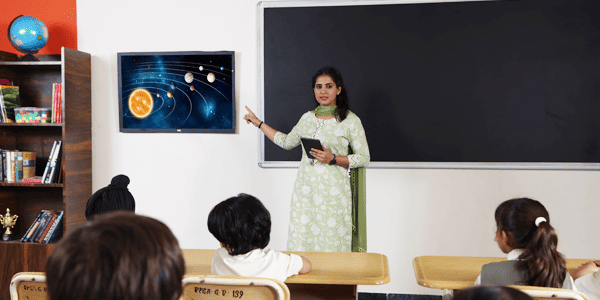Primary Science Tuition Singapore for Building Confidence in Science
Primary Science Tuition Singapore for Building Confidence in Science
Blog Article
A Comprehensive Overview to the Various Understanding Approaches in Primary Scientific Research Direction
The exploration of diverse knowing methods in main scientific research instruction provides a chance for instructors to enhance trainee engagement and comprehension considerably. By checking out hands-on discovering methods, inquiry-based methods, and collective strategies, we can determine reliable practices that provide to numerous finding out designs. Additionally, the integration of innovation and set apart guideline plays an essential function in cultivating an inclusive atmosphere. The question remains: just how can these techniques be efficiently carried out in the classroom to maximize their influence? The answer depends on a more detailed evaluation of each approach and its implications for mentor scientific research.

Hands-On Knowing Strategies
Hands-on understanding strategies play a critical duty in primary scientific research direction, engaging pupils in energetic exploration and trial and error. These techniques allow students to interact directly with products and phenomena, promoting a much deeper understanding of scientific concepts. By utilizing manipulatives, designs, and real-life experiments, instructors create a setting where pupils can observe, hypothesize, and test their ideas.
Such techniques not only improve understanding however also cultivate important thinking and analytic skills. When students take part in activities like constructing basic makers, growing seeds, or carrying out chemical responses, they are motivated to ask inquiries and seek answers with their very own monitorings. This experiential approach assists to demystify complex scientific concepts, making them much more easily accessible and relatable.
In addition, hands-on understanding promotes partnership among peers, as students often function in groups to carry out experiments or share findings. This teamwork not only enriches their learning experience however also establishes essential social abilities. Inevitably, incorporating hands-on strategies in key scientific research guideline fosters a lifelong love of discovering and curiosity regarding the natural globe, laying a strong structure for future scholastic quests in science and beyond.
Inquiry-Based Understanding
Inquiry-based discovering is an educational approach that urges pupils to ask inquiries, explore sensations, and create their very own understanding of scientific principles. This technique moves the focus from typical teacher-led guideline to an extra student-centered experience, where learners take the campaign in their academic journey. By cultivating inquisitiveness, inquiry-based knowing advertises much deeper engagement with the product, permitting trainees to discover topics in a significant context.
In method, this strategy often entails hands-on experiments, monitorings, and critical thinking activities that line up very closely with the clinical technique. Pupils are motivated to formulate hypotheses, style investigations, and assess data, which cultivates vital abilities such as problem-solving and analytical reasoning. The duty of the educator in this framework is to assist in expedition, guiding students through the questions process while encouraging independent thought and collaboration.
Furthermore, inquiry-based knowing supports a feeling of ownership over the discovering procedure, inspiring pupils to go after understanding actively. This technique not only enhances understanding of scientific principles however also promotes a lifelong love for understanding, gearing up students with the skills necessary to browse a progressively complicated world.
Collaborative Discovering Approaches
Joint learning techniques empower students to engage in significant interactions with peers, fostering a shared duty for their educational results. In key science guideline, these methods encourage learners to function together to explore clinical ideas, solve issues, and perform experiments (primary science tuition Singapore). By taking part in team activities, trainees can take advantage of varied viewpoints, enabling for richer understanding and retention of scientific knowledge
One secret facet of joint discovering is the focus on interaction skills. Trainees must verbalize their ideas, listen proactively to others, and discuss concepts, all of which are vital proficiencies in both real-world and scholastic contexts. This social interaction not only improves their understanding of scientific principles however also advertises synergy and dispute resolution abilities.
Furthermore, collective knowing usually brings about raised inspiration and involvement. They are a lot more most likely to take ownership of their discovering trip when students see the worth of their payments within a team. Teachers can facilitate this process deliberately structured group jobs that align with curriculum goals while offering assistance on effective cooperation methods. Overall, including collaborative learning strategies in key science guideline cultivates a dynamic discovering environment that prepares students for future scholastic and social difficulties.
Technology Integration in Scientific Research
The assimilation of technology in main science direction enhances finding out experiences by giving cutting-edge devices and resources that sustain different teaching methodologies, including collective learning - primary science tuition Singapore. The Visit Your URL usage of electronic platforms, simulations, and interactive applications permits pupils to involve deeply with clinical ideas, facilitating a more hands-on approach to discovering
Virtual research laboratories, as an example, enable learners to carry out experiments safely and effectively, promoting inquiry-based understanding. These tools can replicate real-world clinical scenarios, enabling trainees to picture intricate procedures that would be challenging to duplicate in a traditional class setting. Technology fosters communication and cooperation among students, as they can share searchings for and function with each other on jobs with on-line systems.
In addition, multimedia presentations and educational video clips can enhance lessons by dealing with varied learning designs, making abstract principles more easily accessible. Data evaluation devices additionally encourage trainees to gather and translate clinical data, strengthening vital believing skills. In general, the strategic consolidation of innovation in primary science direction not only improves interaction however also prepares trainees for a technologically sophisticated culture, outfitting them with vital abilities for future scientific ventures.
Separated Instruction Methods
Separated direction methods are vital for dealing with the varied requirements of learners in main scientific research education. These techniques allow educators to tailor their mentor approaches to fit varying abilities, rate of interests, and discovering styles within the classroom. By utilizing distinguished instruction, educators can produce an inclusive setting that promotes interaction and boosts understanding of clinical principles.
One reliable strategy is to utilize flexible organizing, which enables students to work together with peers at similar ability degrees or with differing perspectives. This approach encourages peer knowing and advertises important reasoning. Furthermore, supplying selections in jobs can Your Domain Name equip pupils, enabling them to select projects that resonate with their passions while still fulfilling curricular objectives.
Additionally, including tiered jobs is one more useful method. Deliberately tasks with varying degrees of complexity, teachers can guarantee that all students are properly tested, no matter their efficiency. Utilizing formative analyses to determine understanding more makes it possible for instructors to readjust their instructional methods dynamically, making sure that each learner obtains the support they require.
Ultimately, applying set apart guideline approaches in main science education and learning not only improves trainee understanding results however additionally cultivates an interest for science, preparing pupils for future scholastic quests.

Final Thought
In summary, efficient primary science instruction requires a diverse technique that incorporates hands-on knowing, inquiry-based approaches, and joint methods. The assimilation of technology and set apart guideline further provides to varied knowing designs, promoting an environment favorable to expedition and important reasoning.
The exploration of diverse knowing approaches in primary science guideline provides an over at this website opportunity for instructors to enhance pupil engagement and comprehension dramatically.Hands-on knowing methods play a critical duty in primary science guideline, involving students in active exploration and experimentation.Inquiry-based knowing is a training approach that urges trainees to ask inquiries, check out sensations, and create their own understanding of scientific principles.Collective discovering methods equip students to involve in purposeful interactions with peers, cultivating a common obligation for their instructional results. Overall, including collective discovering approaches in main science direction grows a dynamic knowing setting that prepares pupils for future academic and social challenges.
Report this page